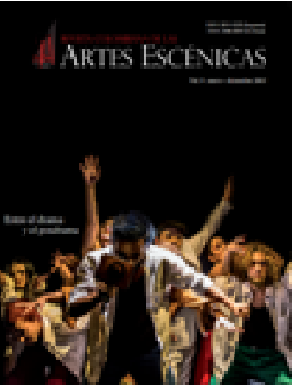Authors
Abstract
Enrolled in visual culture studies, this article is a critical perspective that looks in foreshortened and avoids the colonial, racist and misogynist imperatives of the “big” disciplines, those that, through their mechanisms of generation and distribution of knowledge, have forged stories and legitimate bodies leaving out anything that does not fit into traditional parameters of observation, provided by the knowledge that, since ancient times, formed the hegemony of the Western artistic thought. Through the work of Chilean artists, Elijah Adasme and The Mares of Apocalypse: Lemebel Pedro and Francisco Casas, the possibility of generating distorted perspectives based on the production of resistance and construction of memory stories.
References
Butt, G. (Ed.). (2005). After Criticism. New responses to art and performance. Londres:Blackwell.
Dussel, I. (2009). Entrevista a Nicholas Mirzoeff. La cultura visual contemporánea: política y pedagogía para este tiempo. Revista
Propuesta Educativa, 31, 69-79. Recuperado de http://www.propuestaeducativa.flacso.org.ar/archivos/entrevistas/31.pdf
León, C. (2011). Cultura visual, tecnología de la imagen y colonialidad. Hacia una crítica decolonial de la visualidad desde
América Latina. Recuperado de http://www.centroecuatorianodeartecontemporaneo.org/proyectos/investigacion/estudios-imagen-2/jornada-estudios/christian-leon/leon
Lull, J. (2000). Media, Communication: A Global Approach. New York: Columbia University Press.
Mirzoeff, N. (2002). The Subject of Visual Culture. En N. Mirzoeff. The Visual Culture Reader. London/New York: Routledge.
Mirzoeff, N. (2011). The right to look. A counterhistory of visuality. Durham: Duke University Press.
Padín, C. (2003). Otro mundo es posible, otro mundo es posible, Una crónica de nuestro tiempo a través del arte. Catálogo de la
exposición: Humanizarte. Liga de Arte de San Juan, Puerto Rico.
Pratt, M.L. (1992). Imperial Eyes. Travel writing and transculturation. London: Routledge.
Preciado, B. (2003). Multitudes queer.Notes pour une politique des “anormaux”.Multitudes, 12, 17-25.
Red de Conceptualismos del Sur. (2013).Perder la forma humana. Una imagen sísmica de los años Ochenta en América Latina. Catálogo de
exposición. Madrid: MNCARS.
Richard, N. (2005). Estudios visuales,políticas de la mirada y crítica de las mujeres.En Fracturas de la memoria. Arte y pensamiento crítico. Buenos Aires: Siglo XXI Editores.
Richard, N. (2007). Márgenes e instituciones, arte en Chile desde 1973. Santiago de Chile: Editorial Metales Pesados.
Rogoff, I. (2002) Studying Visual Culture. En N.Mirzoeff. The Visual Culture Reader. London/New York: Routledge.
Wittig, M. (2001). La pensé straight. Paris:Balland.

 PDF (Español)
PDF (Español)
 FLIP
FLIP









